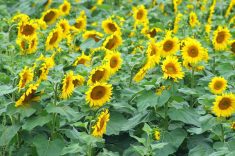One of the most important management decisions for soybean producers on the Prairies is when to put seed into the ground.
Plant soybeans too early and you can run into frosts, adverse soil conditions and other problems that jeopardize plant establishment and early development. It could even mean a washed-out field requiring replanting.
Plant soybeans too late, though, and you could be sacrificing yield, since there are fewer days before the crop’s critical seed pod filling period in summer.
Read Also

Cancer agency reclassifies another herbicide ‘probably carcinogenic’
The WHO’s cancer research agency has now put atrazine, a herbicide well known to corn growers, in the same potential-hazard category where the agency put glyphosate.
Seth Naeve, a soybean agronomist and an agronomy and plant genetics professor with the University of Minnesota, has studied the benefits and risks associated with early soybean planting in northern climes such as Minnesota. He shared some of his research findings with farmers at the CropConnect 2025 conference held in Winnipeg in February.
A good decision
In an interview with Grainews, Naeve explained the main yield constraint for northern-grown soybeans is our shorter growing season. He says the argument for earlier planting dates is in how they can help soybean crops get a jump on germination and plant establishment when fields warm up enough for that to happen.
Naeve’s planting date research includes soybean field trials conducted at four Minnesota locations in 2023 and 2024. The findings showed, on average, planting as early as possible was “a good decision,” according to Naeve.
“We have this challenge in the north in that we have good long days in the spring, but there is just not enough heat there at the same time,” he says.
READ MORE: Check out our Soybean Guide.
“Soybean is actually quite tolerant of planting early and sitting in the soil for a long period of time,” Naeve adds. “Soybeans tend to not come out of the ground until the ground warms up significantly enough … to support germination and emergence. By that time, we tend to be outside of the risk of imminent frost late in the spring.”
Naeve noted a range of management tactics can be useful for lowering risks associated with early soybean planting.
“We can increase populations. We can use a fungicide seed treatment. We can plant shallow or deep, depending on where the moisture is and what the weather forecast looks like. So, there are a lot of things we can do to help reduce the risk that we’re imposing on these soybeans by doing this real early planting,” he says.
Naeve points out the value of early soybean planting may be limited at the earliest end of the seeding window — but it is an incremental value that accumulates over time.
Say, if a farmer decides to hold off planting for a day but is then unable to get back into the field for two weeks — that 14 days can make a significant difference in yield potential, Naeve says.
According to Naeve, the relatively low cost of seed is another risk management consideration for early-planted soybeans.
“Soybeans are relatively inexpensive to replant. If a farmer has a limited number of days to plant, it may be the best risk situation for them is just to plant soybeans early and hold off on some of their other crops like corn (so) they can be then planted under a little bit better conditions,” he explains.
Naeve had one proviso with respect to early-planted soybeans. Findings from the Minnesota study suggest yield responses to planting date are closely tied to how productive the soil is.
In high-productivity environments with good fertility and adequate moisture, early planting with full-maturity cultivars maximized yield. In low-productivity environments, early planting offered no yield advantage.
“If it gets dry or there is low fertility, this trumps any kind of advantage we get from early planting. It basically caps the yield,” Naeve says, noting stressors such as pest infestations and hail damage are also yield-limiting factors.
“If there are other problems that cap our yields, there’s just nothing that we can do. We can’t add more fertilizer. We can’t put on a fungicide. We can’t plant earlier. We can’t do any of those things if the yields are going to be capped by something else.”
Critical period
Naeve discussed some other aspects of his research, which include examining when northern-grown soybeans are maximizing their yield potential.
Naeve says field experiments in three Minnesota locations in 2022 and 2023 indicated the critical yield period was the R4 stage (when rapid pod growth and seed development starts) up to just before the R7 stage (when pods and seeds begin to turn their mature colour).
The testing also identified the R5.5 stage, which typically occurs in late August in Minnesota, as the most important time for soybean yield establishment.
“That corresponds to this idea that farmers have had forever that August makes beans, or late August makes beans, or rains in August make beans. All those things are very true, and we have some data now that really shows why that’s true,” Naeve says.

“If you can support that soybean crop during that most critical time, then it can really make a lot of yield for you,” he adds.
“The way I talk about getting a good crop is, we basically build the machine early in the year, and then at the end of the year, we’re just making seed. If we can get a really nice, large machine built and if we do have good conditions late in the year, then we can really take advantage of it.”
Iron deficiency chlorosis
Naeve also offers some recommendations for managing iron deficiency chlorosis (IDC), a nutrient deficiency that causes yellowing of soybeans leaves and stunted plant growth. In extreme cases it can result in serious yield losses in soybean crops.
He referred to a study by a master’s student of his, Maykon da Silva, called “Strategies for IDC from a Systems Approach: Variety Selection, Iron Chelates and Seeding Rates.”
The research, which involved experiments at 10 Minnesota field sites in 2021 and 2022, examined trade-offs and interactive effects between soybean varieties, populations and iron chelate rates across a range of IDC levels.
Iron chelate products can help mitigate IDC in soybean by maintaining iron in a soluble form that can be available to the plant early in the season.
Naeve notes FeEDDHA, or ortho-ortho iron chelate, is commonly used for this purpose, but he cautions not all of these products are the same. He recommends farmers look for products containing higher levels of iron in the ortho-ortho form, because they are generally more effective against IDC.
The IDC testing results suggest soybean producers would be wise to consider applying iron chelates to any fields with a history of IDC, he says.
The study, he adds, showed better crop results with iron chelates used as in-furrow treatment rather than a foliar application.
“There are a number of factors that all go together to make (foliar applications) not very good practice,” Naeve says. “It’s better just to put (iron chelate) in the soil where the plant can access it.”
Soybean foliage doesn’t absorb minerals such as iron chelate nearly as well as the plant’s root system, he says — and soybeans seriously afflicted with IDC don’t have much leaf material left in any case.
Naeve says findings from the Minnesota study also suggest choosing a variety with the highest rating for IDC control offers the best defence for soybean crops.
“It also comes with relatively little cost. Those (IDC-tolerant) varieties don’t necessarily have a yield penalty, so just picking the right variety is of utmost importance” — and this can be particularly true in fields with severe IDC conditions, he says.
Naeve stresses it’s also important to select “proven” soybean varieties that have been adequately tested.
“I think practically speaking, the biggest risk here is that farmers grow new varieties that are relatively untested for IDC. That’s one of the bigger issues, and that’s a problem we see with industry rolling out these varieties quite quickly.”
Naeve says he’s found that to be particularly true with new herbicide traits in soybean. “Those first varieties that come out tend to really lag for IDC tolerance and/or resistance.
“Certainly, in the United States, we have so many new varieties come out and sometimes they get pushed to the market without good testing,” he says. “I know Canadians have a much better program for releasing and testing soybean varieties than we do in the U.S. It is much more conservative, so hopefully those get weeded out better than what we have here.”
Another finding from the Minnesota study was that bumping up seeding rates to increase soybean populations can be a beneficial practice for managing IDC. The research shows a higher seeding rate had a small but consistently positive effect on yield.
“I think if they’re concerned about IDC, farmers can increase their seeding rates a little bit,” Naeve says. “It’s a small benefit, but it is large enough to pay for the additional seed cost.”
















